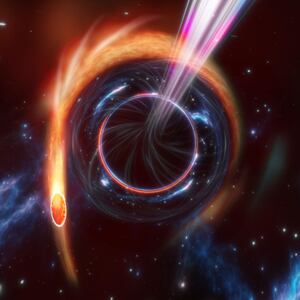In 2019, scientists made history after they released the first ever image of a black hole—well, kind of. We can’t see a black hole with our naked eyes. So using the Event Horizon Telescope (EHT), the team was able to capture the bright silhouette of super-hot gas and plasma swirling around the black hole at the center of the Messier 87 (M87) galaxy.
While that description might lead you to believe that scientists snapped a stunning and epic photo of an immense black hole capable of tearing planets and stars apart and consuming it with an insatiable hunger, the actual photo ended up being a bit… fuzzier. In fact, the photo looked more like a blurry orange donut.
Recently, however, scientists were able to use machine learning to give the old photos a small makeover.
ADVERTISEMENT
Take a look.

M87 supermassive black hole originally imaged by the EHT collaboration in 2019 (left); and new image generated by the PRIMO algorithm using the same data set (right)
Medeiros et al. 2023The new image shows more of the darkness of the black hole itself and shows a clearer outline of the bright, superheated gas that surrounds it—making it a slightly skinnier orange donut. To obtain this new image, the researchers used a machine-learning algorithm called PRIMO, which stands for principal-component interferometric modeling. They published a paper of the process on Thursday in the journal The Astrophysical Journal of Letters.
“With our new machine learning technique, PRIMO, we were able to achieve the maximum resolution of the current array,” Lia Medeiros, an astrophysicist at the Institute for Advanced Study and lead author of the paper, said in a statement. She added that the image allows researchers to gain a better understanding of black hole behaviors since “we cannot study black holes up close.”
The beauty about a tool like PRIMO is that it helps fill in the gaps that are left by our current methods of capturing black holes using the EHT, which requires a network of seven telescopes around the world. These telescopes can only capture small portions of the black hole, which means that there are also holes in the data—that’s where PRIMO comes in.
The model is trained on datasets of more than 30,000 simulated images of black holes collecting gas. This allowed PRIMO to essentially make very educated guesses as to what M87 actually looks like when seen more clearly.
“We are using physics to fill in regions of missing data in a way that has never been done before by using machine learning,” Medeiros explained. “This could have important implications for interferometry, which plays a role in fields from exoplanets to medicine.”
The authors add that PRIMO could be used to help fill in the gaps for other astronomical data and images such as the snapshot of the black hole at the center of our Milky Way (Sgr A*) released last year.
“The 2019 image was just the beginning,” Medeiros said. “If a picture is worth a thousand words, the data underlying that image have many more stories to tell. PRIMO will continue to be a critical tool in extracting such insights.”






